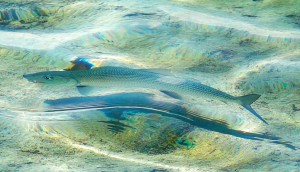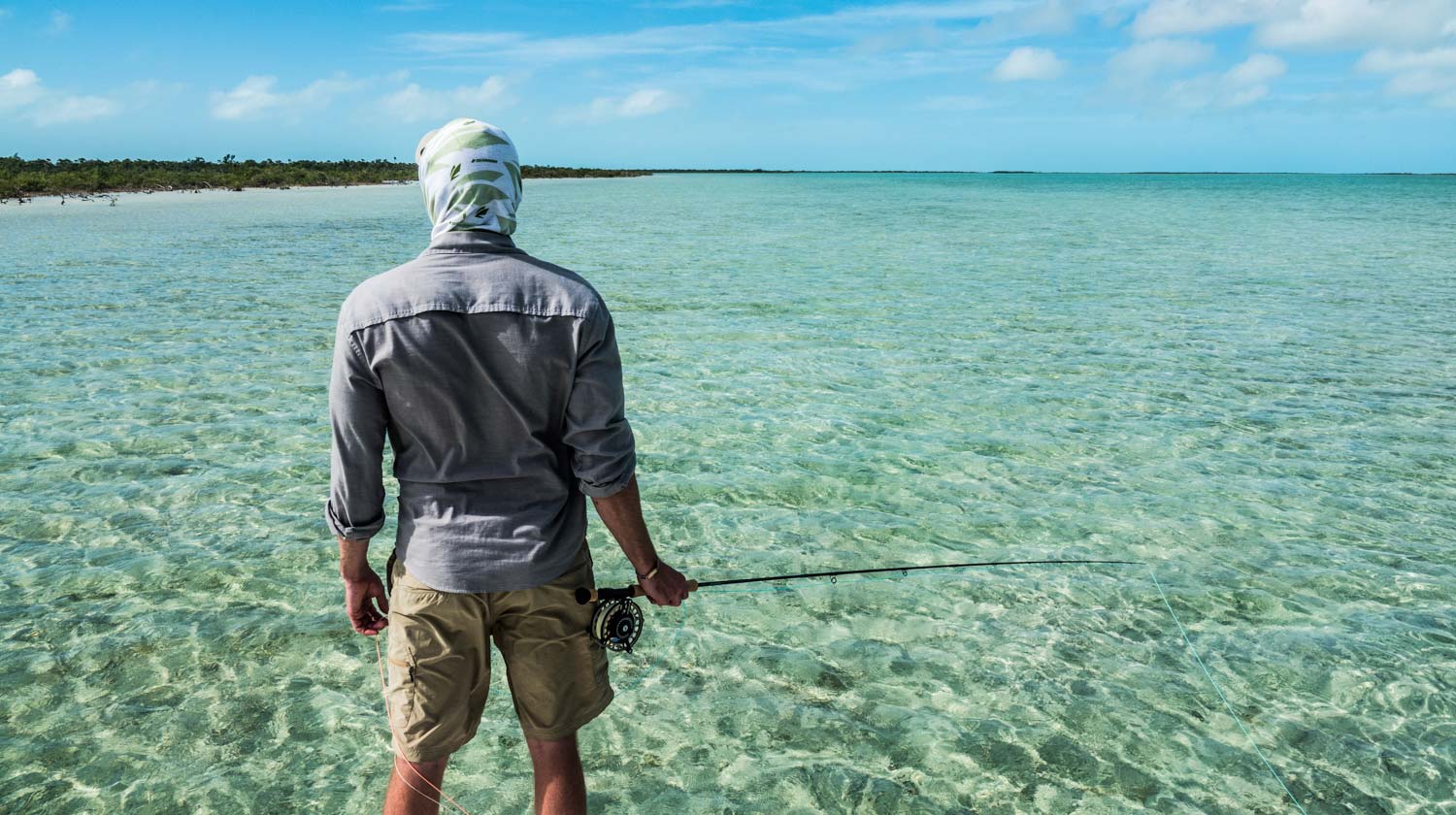By Jason Tucker
“Jason, give me a cast, tight to the mangroves, forty feet.”
This from my guide, Harlon, who is working his ass off poling the skiff in a howling wind and stiff current while I stand on the bow staring holes into the water.
“Three o’clock, you’re behind him, cast again.”
This is said with an odd mixture of Bahamian urgency and diffidence. What this means for me is a forty foot cast almost directly into a hard wind with the mangroves only providing moderate relief. Harlon shakes his head and returns to scanning the water and poling while I strip my line in and get back in the ready position. It has been a frustrating week and day for me.
Bonefish are easy to catch if you can get a fly in front of them without spooking them. And there’s the rub. You have a window as big as maybe six feet to get it in front of them, but if you hit too close they’ll spook. If you cast over them or they see your line they’ll spook. If you can’t make your cast in the wind they won’t see it. And they almost universally spook at anything that hits the water behind them. Also, in the gray and rainy conditions we had, they are extra spooky.
I have never tried to portray myself as an expert in any aspect of fly fishing. I am an enthusiast who fishes a lot and catches some fish as a result. But after awhile you like to think that you have some journeyman skills. I have spent long days casting a twelve-weight rod for muskies, entire summers spent fishing at night for brown trout, and cast my heart out on the Lake Michigan flats in the Straits of Mackinac for carp in thirty mile an hour winds. None of these are as challenging as my experience bonefishing.
Let me say right now, that if you have already gone after bonefish, you know what I’m talking about. If you haven’t, I’m writing this to help you prepare, but you must prepare.
Here is the scenario. The week I went to Bair’s Lodge on South Andros, Bahamas, we had exceptionally bad weather. According to the guides, January is frequently a month of drought, but we had four and a half days of heavy rain, gray skies and whipping winds. It was tough for everyone including the guides. But no one catches fish sitting in the lodge, so we went out every day, made the most of it, and you know what? Every day at least one boat got into fish and had a stellar day regardless of the weather.
 What this meant for us was greatly diminished sight conditions and fleeting shots at bonefish. If you didn’t capitalize on your shots it made for a long fishless day. How it worked out was we typically did not spot fish until they were within forty feet. The wind was blowing so bad that even a thirty-foot cast was challenging, frequently blown off course, and impossible (for me) if directly into the wind. The boat is moving, the fish are swimming from any random direction, and you have scant seconds to react. With the fish scattered and spooky because of the weather, you stood on the bow for long periods straining to catch a glimpse of anything, then having to react suddenly and accurately under terrible conditions. In the best of conditions I have to cast consistently to gauge my casts. I find it extremely difficult to stand on the bow for twenty minutes, then make an accurate cast and gentle presentation instantaneously, while trying to divine the directions of the guide, spot the fish and fight the wind.
What this meant for us was greatly diminished sight conditions and fleeting shots at bonefish. If you didn’t capitalize on your shots it made for a long fishless day. How it worked out was we typically did not spot fish until they were within forty feet. The wind was blowing so bad that even a thirty-foot cast was challenging, frequently blown off course, and impossible (for me) if directly into the wind. The boat is moving, the fish are swimming from any random direction, and you have scant seconds to react. With the fish scattered and spooky because of the weather, you stood on the bow for long periods straining to catch a glimpse of anything, then having to react suddenly and accurately under terrible conditions. In the best of conditions I have to cast consistently to gauge my casts. I find it extremely difficult to stand on the bow for twenty minutes, then make an accurate cast and gentle presentation instantaneously, while trying to divine the directions of the guide, spot the fish and fight the wind.
Suffice it to say that this was the most challenging fishing I’ve ever done. Here’s what I plan to do before I go back.
Practice my double haul. We all say we will and never do. It’s time for me to move on from knowing how to double haul, to having the moves be automatic and instant. A lot of times I found myself simply waving my rod around, my focus blown by the sudden appearance of fish, when I should have been hauling.
Learn how to cast in wind. Gink and Gasoline has posted articles and videos on drills you can practice to increase line speed. It is impossible to cast in wind effectively without having practiced these drills. When you are standing on the bow for twenty minutes and then your guide calls out a fish you need to wind up your cast and deliver it within about 3 seconds. That is not an exaggeration. I frequently found myself just getting my cast up to speed as the fish was already exiting the sight window, or had spooked from the boat.
Practice casting accurately. One drill that Louis recommends is setting out three hula hoops in your yard at various distances and directions. Practice casting accurately to one hoop, then pick up and lay down accurately to the next hoop then the next. Vary the order you cast to. Move the hoops around. Set one up on your back cast. Try to eliminate extra back casting. The goal is to pick up and load with that first back cast and deliver accurately with no further casting.
Practice my back cast. The guides at Bair’s are always striving to set you up for a twelve o’clock cast or onto your forehand. But bonefish have their own plans and frequently show up on your back hand. Being able to make this shot effectively can greatly increase your opportunities.
Practice my short game. It seemed like some of the hardest casts I tried to make were under thirty feet. When standing at the ready position (fly grasped at the hook bend, with leader and nine feet of fly line out of the rod tip) it felt difficult to pull that in and make an effective presentation in under thirty feet, and a surprising number of fish gave us presentations that close. I botched most of them, with most of my fish from the boat coming between thirty and forty feet. The guys I fished with didn’t seem to struggle with it as much as I did, and some hooked up on fish at their rod tip.
Don’t let anything I’m saying here discourage you from booking a trip for bonefish. Despite the bad conditions I caught my share of fish, and the tough conditions made each fish that much more satisfying. If you can get the fly in front of them without spooking they readily eat, and there is nothing like the blistering run of a good bonefish. The weather we experienced was unusual. On the nice days we had we could see more fish much further out, and were able to prepare and get our false casts (and distance/accuracy) in just as the fish came in range. The dozen guys in our group represented all skill levels except rank novice, yet everyone managed to have good days where they consistently caught fish. Let the tough conditions I’m sharing with you move you to practice, practice, practice your casting and presentation. A weeklong trip for bonefish doesn’t come cheap, and if you’re going to get the most out of it, you need to be prepared. You likely will experience rain and high winds at least one day in your trip, but probably not to the degree that we endured. If I can catch fish in those conditions, you can too, and anything else should be gravy.
Jason writes the fine blog Fontinalis Rising
Jason Tucker
Gink & Gasoline www.ginkandgasoline.com hookups@ginkandgasoline.com Sign Up For Our Weekly Newsletter!
Sign Up For Our Weekly Newsletter!


The hardest thing to cope with is the wind. Prior to my first trip to Kiritimati I did a lot of practise in the 40 to 60 foot range with three targets (600mm dia whoops made from garden hose) and thought I was prepared for the wind. I was out on the flats by 10am the day I arrived and could not believe the wind. That trip the wind was constant and varied from 15 to 35 knots so initially it was a baptism of fire. My guide showed me a few tricks particularly a back hand cast where the rod tip was never above waist height and the haul on the forward cast wast a short (150mm/6”) and very vicious one.
I went on and enjoyed my seven days fishing. I got 6 species including 84 Bones so I was happy. I have been back on two more trips and the Bones total is 345. My slowest day was four and the best was forty seven Bones. I’ve made thousands of casts since that first day at Kiritimati in 2010 and the wind doesn’t worry me. I have also had other fly fishers on trips ask “how did I get the fly in there in this wind” and I have said “ah, I must be lucky”. I don’t mention the hours I put in with practice and I rarely miss a windy day.
Nope. I am not ready for bones. But I’m also not ready for spotted bass, striped bass, crappie, or trout. And if the flu and my work schedule don’t ease up soon, I won’t be ready for anything this year.
If I was on the flats right now I wouldn’t give a shit if all my casts failed. I’d lay me down in the water and bubble and laugh.
Love to all from my northern Mississippi paradise.
I went last minute, so that is exactly what I did.
Been there brother! But you gotta go back and it will get better.
Not ready indeed! First time I went after bones was Boca Paila a couple years ago. DIY was the goal and I did research to find the wadable flats. I’m a good caster and have spent years chasing striped bass on the flats of Cape Cod. What I wasn’t ready for was the incessant 30 mph onshore winds the entire week and the generally cloudy skies that ruined visibility. But most of all, I was not ready for the presence of saltwater crocodiles that made me too nervous to attempt to cross the 4 foot deep channel to the bonefish flat. Even walking the trail through the brush to the beach to cast for snook made me as nervous as a cat. Then, standing on the bridge over the main channel, I spied an 8-footer (a little one!) lying on a sand bar. Next time I’m hiring a guide and fishing from the safety of a boat.
That is a whole lot of yikes.